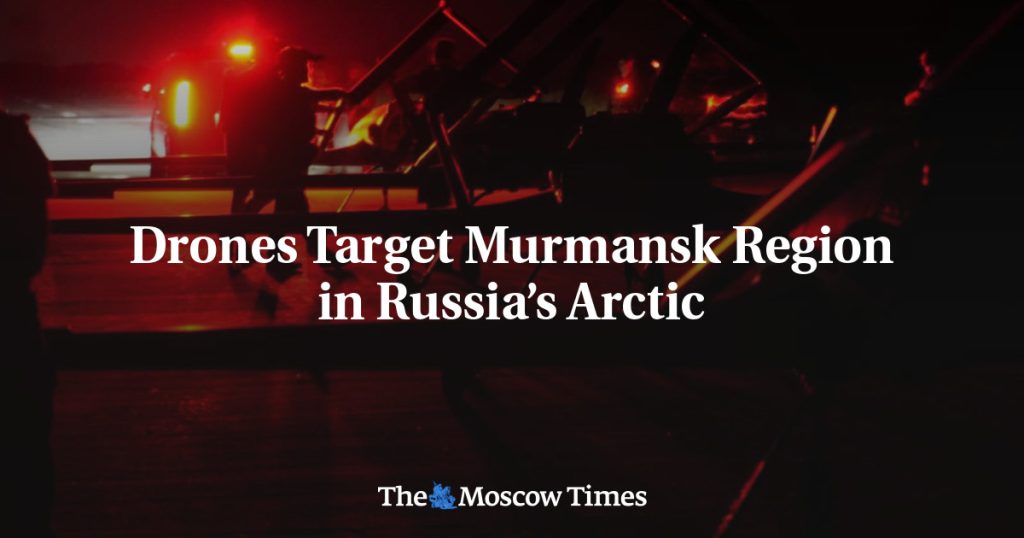Military drones targeted northwestern Russia’s Murmansk region for the second time in a month, leading regional authorities to restrict air traffic at airports in Murmansk and Apatity. Governor Andrei Chibis referred to the drones as an attack from an enemy, potentially referring to Ukraine. The region’s emergency response center tested its air raid alert system during the reported drone attacks, reassuring residents to remain calm. While the Defense Ministry did not confirm any drone sightings over the Murmansk region, it claimed to have shot down Ukrainian drones over other regions. Unconfirmed reports suggested that the drones flew from the border with Norway, with some heading towards the neighboring Arkhangelsk region.
The Defense Ministry reported that its air defense systems had shot down Ukrainian drones over the Belgorod, Kursk, and Oryol regions, but did not mention drone sightings in the Murmansk region. Unverified reports claimed that the drones over Murmansk originated from the border with Norway and that some were headed towards the Arkhangelsk region. The city of Murmansk is located around 2,000 kilometers from Russia’s border with Ukraine. The former coordinator of Alexei Navalny’s activist organization in the Murmansk region noted that this was the second drone incident in the region within two days. The first drone attack in the region since Russia’s invasion of Ukraine over two years ago occurred in mid-August.
The reported drone attacks in the Murmansk region coincide with a testing of the air raid alert system, leading to restrictions on air traffic at airports in Murmansk and Apatity. Chibis stated that air defense forces were working to destroy the enemy drones, but did not specify if there was any damage on the ground. The response center urged residents to remain calm during the testing of the air raid alert system. Unverified reports suggested that the drones originated from the border with Norway and were potentially flying towards the Arkhangelsk region. Despite the lack of confirmed sightings by the Defense Ministry, the region remains on high alert following the reported drone incidents.
Russian authorities in the Murmansk region have reported a second attack by military drones within a month, leading to restrictions on air traffic at airports in Murmansk and Apatity. Governor Andrei Chibis described the drones as coming from an enemy, which could potentially refer to Ukraine. The emergency response center reassured residents to remain calm during the reported drone attacks, coinciding with a scheduled maintenance of the air raid alert system. While the Defense Ministry did not confirm any drone sightings over Murmansk, it reported shooting down Ukrainian drones in other regions. Unverified reports indicated that the drones over Murmansk may have come from the border with Norway.
The recent reported drone attacks in the Murmansk region come amidst a testing of the air raid alert system and restrictions on air traffic at local airports. Chibis emphasized that air defense forces were working to destroy the enemy drones, but did not provide details on any potential damage. Unconfirmed reports suggested that the drones originated from the border with Norway and may have been heading towards the Arkhangelsk region. The city of Murmansk is located far from Russia’s border with Ukraine, where the Defense Ministry reported shooting down Ukrainian drones in other regions. The former coordinator of Navalny’s activist organization in the region noted that this was the second drone incident within a two-day period.
The reported drone incidents in the Murmansk region have raised concerns and prompted heightened security measures, including restrictions on air traffic and testing of the air raid alert system. The involvement of military drones in the region, potentially originating from the border with Norway, has led to increased vigilance and response from air defense forces. While the Defense Ministry did not confirm sightings of drones over Murmansk, it reported intercepting Ukrainian drones in other areas. The ongoing tensions and unverified reports suggest a complex security situation in the region, calling for continued monitoring and readiness to respond to potential threats.


